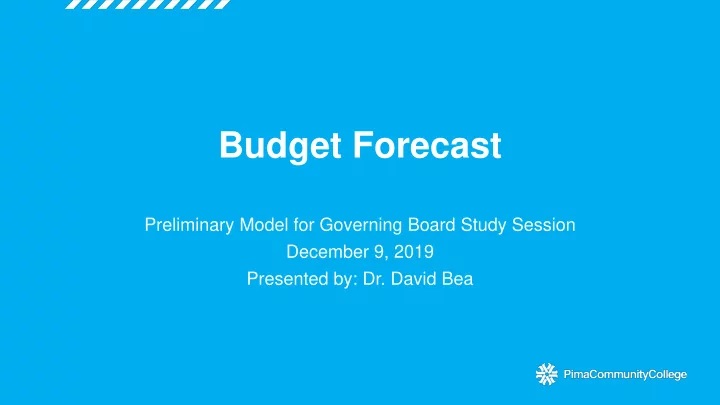

Budget Forecast Preliminary Model for Governing Board Study Session December 9, 2019 Presented by: Dr. David Bea
Objectives 1. Review Budget Forecast 2. Discuss Priorities, Challenges, and Opportunities 3. Develop Preliminary Scenario Outlines and Identify Follow-Up
Base Budget Structure • Steady local and national economy • Budgeted positions as of August 2019 • Flat tuition • Flat enrollment • No change to classroom funding model • Maximize available expenditure limitation (EL) exclusions • No additional long-term debt in the near future
Model Outcomes: Base FY20 FY21 FY22 FY23 Current Unrestricted Fund Revenues 175,950,857 181,147,618 185,768,167 190,628,356 Personnel Expenses 110,246,853 110,584,896 110,511,453 110,628,677 Operating Expenses 30,582,637 29,527,073 29,507,978 29,538,456 Budget Parameters Reserves/Transfers 29,672,367 29,612,301 29,569,517 29,569,517 Revenue Bond Debt Service 5,449,000 5,854,988 6,209,488 6,569,238 Subtotal Expenses 175,950,857 175,579,258 175,798,435 176,305,888 Budget Surplus/Deficit 0 5,568,360 9,969,732 14,322,467 EEC Expenditure Limitation 101,397,530 87,036,692 89,212,813 90,752,261 Expenditure Limit Budgeted Exp Subject to EL 96,763,228 90,355,401 89,104,534 90,944,802 (Under)/Over Plan Target EL -4,634,302 3,318,710 -108,279 192,541 In State Tuition Increase % 2.4% 0.0% 0.0% 0.0% Tuition/Market Tuition and Fees/Credit vs. AZCC Avg TBD TBD TBD TBD Tuition % of Operating Revs 23.7% 23.0% 22.4% 21.9% Budgeted GF Ops Exp per Total FTSE 9,529 9,472 9,971 9,872 Est FTSE per FTE Position 12.6 12.6 12.6 12.6 Stewardship Tax Rate vs AZCC Average TBD TBD TBD TBD Salary Pool Increase Less CPI -1.00% -2.50% -2.50% -2.50% Composite Financial Ratio 6.60 6.51 6.36 6.60 Financial Indicators Viability Ratio 2.94 2.79 2.71 2.89 Remaining Rev Bond Capacity ($mil) $9.4 $8.9 $8.6 $8.2
Actual/Estimated Expenditures vs. Expenditure Limitation $140,000 $120,000 $90,355 $100,000 $80,000 $60,000 $40,000 $20,000 $- 2011 2012 2013 2014 2015 2016 2017 2018 2019 2020 2021 2022 EL ($000s) Actual ($000s)
Budgeted Salaries by Program Type, FY15-FY20 (General and Designated Funds) $60,000,000 $50,000,000 $40,000,000 $30,000,000 $20,000,000 $10,000,000 $0 2015 2016 2017 2018 2019 2020 1-Instruction 3-Academic Support 4-Student Services Inst Sppt & Plant
FY20 General Fund Revenues and Expenses FY20 General Fund Revenues by Source FY20 General Fund Expenses Share by Type Investment Debt Service Administrative Other Income Income Faculty 3% 3% 2% 2% Transfers & Reserves 12% 17% Tuition & Fees 28% Adjunct 8% Operating 17% Property Taxes 68% Staff Classified Other Compensation Fringe Benefits 23% 3% 14%
Challenges • Struggling enrollment and declining outlook • Limited potential growth in other revenues • Structural inefficiencies and continued resistance to reductions • All services at all places • Classroom inefficiencies (scheduling, course capacity) • Funding College priorities with limited EL capacity • Reallocating resources
College Priorities and Goals • Increase enrollment: recruitment, persistence, retention • Increase marketing budget • Increase institutional scholarships • Increase professional advisors and advisor:student ratio – reallocate and add resources • $0 classroom materials, integrated technology • Increase dual enrollment • Increase online enrollment programs • Decrease utility costs College-wide • Continue establishment and enhancement of COE as outlined in EMP and FMP • Compensation adjustments • Classification/compensation study • Merit pay pool • Adjunct faculty tiers • Hard-to-fill positions
Strategies and Opportunities • Increase capital leases and other financing methods for deferred maintenance • Prop 301 to fund workforce program operating expenses • Discontinue non viable program/courses and reallocate resources – Implement program and course viability studies to eliminate ineffective programs by FY22 • Reduce fringe benefit costs by shifting some cost increase to employees • Aggressive or moderate tuition increases for three years • No salary pool increases in FY21 • Fund Allied Health and Science Building through capital reserves – Proposed $10M per year • Position freezes/retirement savings
Funded Priorities by Scenario Example Strategies Continued Position Reductions $650,000 Benefits Premium Increase $250,000 Tuition Increase ($1.00 per credit hour) $450,000 Subtotal of Revenue Increases/Cost Reductions $1,350,000 Marketing $1,000,000 Scholarships $200,000 Advisors (5 @ $75K per position) $375,000 Adjunct Faculty Pay (3%) $600,000 Cost of Living Adjustment (1%) $1,100,000 Subtotal Priorities -$3,275,000 Net EL Impact -$1,925,000
Additional Resources
Links to Additional Information • Financial Ratios • Financial and Operational Performance Indicators • Benchmarking Metrics • Expenditure Limitation Information • Understanding Property Taxes
Cash and Investments vs. Operating Expenses, FY04-FY18 200,000,000 150,000,000 100,000,000 50,000,000 0 FY04 FY05 FY06 FY07 FY08 FY09 FY10 FY11 FY12 FY13 FY14 FY15 FY16 FY17 FY18 Cash and CE ST Invest LT Invest Operating $
Ratio of Cash & Investments vs. Operating Expenses, FY04-FY18 80% 70% 60% 50% 40% 30% 20% 10% 0% FY04 FY05 FY06 FY07 FY08 FY09 FY10 FY11 FY12 FY13 FY14 FY15 FY16 FY17 FY18
College Comparison of Available Reserves Ratio, FY18 200% 180% 160% 140% 120% 100% 80% 60% 40% 20% 0%
Recommend
More recommend